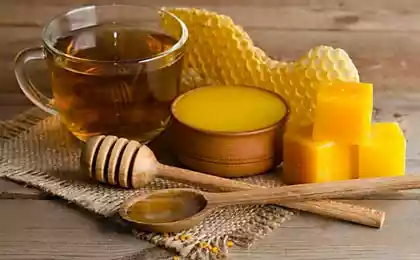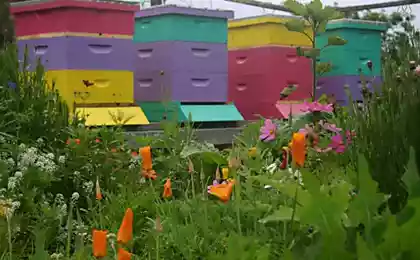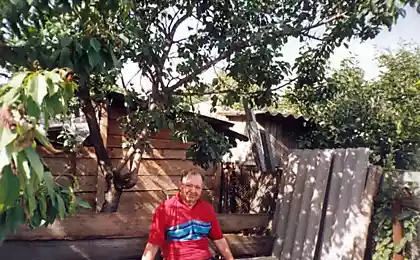558
Honey from the deck. Practice
Fifty nine million two hundred eighty nine thousand eight hundred sixty three
What is different about homemade egg incubator from? Fresh milk of their cows or goats, nagulea it on the clean and fragrant water meadows, from the fact that at the farm, even equipped with the latest technology? Carrots and apples from your garden from those grown on the collective farm? That is the difference between and Kolodny honey from the honey in the hive, even under the most "gentle" mode, their contents. And it's not a fairy tale, not a figment of my imagination and of the imagination, but a living reality, tested by me in practice.
I have two jars of honey: one from the deck, another from the hive... All year hive and the deck was standing 15 feet from each other, but it's two different worlds, two different lives, two different tastes, two different flavor. Anyone tried it at a conference in Gelendzhik, this year, he confirmed.
It all started with the deck, but segued into a beehive, as ROI now in free flight in a big "favor". Beekeepers don't like this process, strongly warn him, in one way or another by intervening in the lives of bees. It is not beneficial to the family will gather less honey, although Butkevich, a famous Russian beekeeper, confirmed the ineffectiveness of protivobolevykh techniques, actively using flying swarms to generate large families of "honey". These families, in total, collected a lot more honey than even a strong family, who mostly try to maintain a modern beekeepers.
In General, after several attempts to get Roy, I had to go on the beaten track: to by calopake, to raise his family and get away from it Roy — it may, at this stage, one of the best options of settlement of the deck, but it all of course depends on the terrain and "radiosty" surrounding beekeepers.
So, in view of the circumstances, I had to master the technology of maintenance of bees in the hive in its classical version and in parallel to create a new family with his first deck.
Luckily, the teachers were not lacking: around four "powerful" Krasnopolyanskaya apiary is in the Caucasus in the Adler area,- beekeepers are masters of their craft, many of them hereditary. People are good, kind, hard-working – something similar to their small, winged toilers, but their life is such a word as "plan", and for the private beekeeper – "income" and, most important, a certain way of thinking, almost not allowing the idea that bees can be kept or another. In their minds created a setting that the science of beekeeping has almost reached its "heights" and all the rational has already been achieved in the forms of organization of apiaries they use. Yes, it is, but only if you have a goal to get as much production output, and to earn accordingly.
What it costs a beekeeper? – a full plate! Beekeeping is a very, very busy. Almost two-thirds of the time mental and physical activity the busy technology and manipulation.
What will it cost the bees? in their gradual degradation and degeneration. Even 40-60 years ago these valleys were warmly greeted by the sonorous song, inhabiting hollow trees and rocky niches, swarms. Now it is very rare. Beekeepers themselves are responsible – bee is not the same, does not survive in wild conditions.
Do, and how to survive, because from year to year, we constantly improved the design of the hive with the sole purpose of convenience in work, maximum return, Yes, to treat and transport was handy. But at the dawn elevage beekeeping, the outstanding Russian beekeepers are recommended to constantly update the apiaries gene pool of wild bees, as even then it was noticed that the bees in the hive and with such a concentration of hives in one place, gradually degenerates.
Where is the pride, beauty and wealth of Russia – Central Russian bee? Where thoroughbred gray mountain Caucasian?....Mutants.… !
About how it happened and is happening even do not want to talk to any beekeeper that he knows. The idea is the same – the cross breeds with the aim of obtaining the maximum productivity for the honey flow, not thinking about the fact that the formation of these properties occurred for thousands of years and that these qualities of the breed that is most optimally suited to the environmental conditions where they exist.
Treating me well, my idea about the content of the bees in the deck, the beekeepers were very skeptical – pampering... But the goals we were different.
The deck on the site is: live the all-pervading life in direct and figurative sense of the word – she greets You and the first rays of the sun the joyful roar, hurrying about their business of bees; she will give You, even a little, but the amazing qualities of honey, pollen, bee bread and wax; it will pour You, because of their design, powerful honey aroma during the bribe, which has unique healing properties; it will make Your harvest much richer and more useful and, most importantly, it does not take time!!!
You will approach it with a "working" visit twice a year: in autumn for honey in the spring to clean the bottom of debris and to determine the strength of the family (if selected too much honey or the winter was unusually severe, you'll have to share with them our reserves for the spring). Everything else they do themselves, Your Hands and Thoughts will be Free !
But the main objections of beekeepers seemed quite reasonable: "As you from verrucose to treat and how to get honey?»
So I tried to get answers to these questions in practice, especially when you consider that in the winter of 2003, the year in Russia killed at least 30-40% of all bee colonies all from the same verrucosa, in spite of all modern methods of dealing with this disease.
My hive gave me amazing Roy was Roy, almost 3.5 kg, which was planted next to the punching bag and hung on a branch in the shape of a large pear. Shaking off it into rainy, we almost immediately fell asleep in his deck, pre-lidovou close up the gap, partially disrupting the beekeeping canons in which it is said that a swarm should be left in roenne on the night and the next day to settle into a new home, so that they will not disappeared. But our Roy volatilize and didn't the next morning we opened lidovou slit and bees together began to develop new housing.
A little about the deck. I did it, of course, in haste, now already have more "neat" option, but adhering to all the main criteria and parameters to manufacture, which is listed in the book.
I found in the forest a fallen oak. Sawed with a chainsaw for a suitable long range( how to make boards described in the book), as well as two circular saw cut at the ends of the ridge, thickness of 5-6cm for the top and bottom covers, one for the bottom. The "select" internal cavity when the ends are open, and the bees to settle comfortably across the top, well then you can score the top cover tightly, so as not be tempted to remove the honey from the "head" — Not! This is their winter reserve and the bees are very sensitive to its presence. Summary of wintering, the welfare of the family in the spring directly depend on this stock. Select honey from the bottom end, and why will become clear later. Further, the ridge sawn exactly in half (heavy – even a two to raise) and a chainsaw, a chisel, a special tool is selected the internal cavity in each of the resulting halves. Had not sawed, and a long "drill" drilled center hole, and then luchkovoj a saw in a circle, cut out the core. Then the halves are adjusted to each other and are fastened( bolted), first along one of the seams making one long one or a series of letkov as written in the book. It is now necessary in the United state to give it to dry up, because no matter how dry it may seem – will shrink. After once again carefully to fit and make the end caps from sawn circles – either inside, or overlapping, in accordance to the rules in the book dimensions along the length of the deck. The top lid can be initially a blank wall, but then when you check the swarm, the deck will have to put on the end and cover Roy through the bottom cover. Lower can be done on the eyes, but be sure to seal and beat down with a cloth as written is that they to her cell is not molded and will not open the year after that. Then place the stand so that the angle of inclination relative to the horizon was 20-30 degrees and installed on the site, but so that in the heat of midday (important for the southern regions) it was in the shade, but during the day got as much light as possible, that is, under a small tree hole to the South, but better on the second floor of the house. Why?
Because under natural conditions bees prefer to settle in the hollows of living trees in the upper 1\3 parts, so that the air drier! and winter better.
So what did you start with a housewarming party my little toiler? With the construction of his new home. Winter is not far off from how quickly and efficiently they do it and how suitable are the conditions for their housing will depend on the life and fate of their little family.
First thing — cleaning and propolisovaya nests, and especially of the hole( I made one long).They all zaproponowali he was making for himself throughout the length of the round holes is their "sanitary inspection" (propolis is a powerful antiseptic) and, each bee getting into the deck through that "hole" returning home is the primary "hygienic" treatment. In the hive they do the same thing, but beekeepers try periodically to reclaim the space of the hole from "unnecessary obstacles", especially in the spring, in order to self-regulate its lumen as they need,
based on the current situation in the apiary. In the deck the same bees can regulate the gaps of their "letkov" — increasing or decreasing the number of "holes" – as they need.
Thanks to this their work, it became clear why the need for the tilt of the deck in 20-30 degrees from the horizon level. All ingenious is simple. The main problem of wintering bees in the hive – the problem of fresh air. What bees closer to winter?
To plug the Central hole, leaving them open only in the lower and upper part of the hole. Yes, dear reader and future beekeeper, You guessed it – the difference in height between the upper and lower "holes" makes for a good flow-through ventilation and this is essential, as a Guarantor and Condition for safe wintering, as, unlike a live tree, natural tree hollows, which absorbs the excess carbon dioxide in the deck, as in the hive during winter should be good ventilation.
One million four hundred sixty three thousand seven hundred forty six
The precision and beauty of thought of the designer is revealed and confirmed their seriousness and practicality!
Then, or rather simultaneously, bees begin to rebuild "languages", but rather, a honeycomb is the basis of your inner Home. And here we face at once the differences correlated with the hive. In most modern hives, combs relative to the notch are arranged "in the end" (cold skid) that dictates the bees, the beekeeper of the design of the hive – they have nowhere to go. Here bees build a honeycomb in relation to the notch "along" (warm skid) – it is their nature. They also come in a hollow, they also come in the deck. If the notches are done at the end of the deck, they will build honeycomb not along and across the deck.
Earlier in the Ukraine and North Caucasus were widely distributed such constructions "decks – deck chairs" consisting also of two "hollowed out troughs" with face hole and slightly raised "head," and omitted the "fifth", but the tap hole was in the side and honey was removed when raising the top with the cells, cutting the excess. The design of this deck was the basis of the modern beehive – lounger, however, all in the same "neutered".
Why don't we use this design? But, first, because it is almost horizontal, and, therefore, no effect of elevation and flow-through ventilation. And, secondly, extracting honey, the beekeeper may, if they wish, to take it from any part of the socket La of bees is also vital and necessary to the stocks of honey and pollen over the winter the club was untouchable. The constant presence of this "top" of the supply of honey throughout the season the bees know where it lies every drop in their House must, above all, for their psychological health. They are confident in their future, their "Queen" works without stopping (depending on the needs and situation in the family).
What is it in our deck? The precision and beauty of thought of the designer is revealed and finds practical confirmation in the solution of this question here.
Twenty seven million one hundred seventy five thousand one hundred nineteen
The internal logic of the arrangement of bees in its nest of honey, pollen and brood unchanged and consistent with their internal needs. Created by the Creator Thought, but in what it results, depends on the specific conditions of their existence, that is the design of the House in which they live. They will be there to try to build my own, but adapting their way of life to external conditions. So, as we can see from the picture, built along the length of the deck honeycomb bees to place their brood — in front of the hole, the pollen closer to the brood and honey for the rest of the Sota space: above, from above and below. The fact that the "head" and the top is their "emergency supply" to whom was discussed above. What in the "heel" — so, just to be greedy don't, brood damage, if at the time of selection, he will still be.
Those 30-40 cm, which notches does not reach the bottom of the cover is "your space" honey — where the bees will only add the honey, there is no hole! And the taste of your honey is unique because it will polimernym (mnogokomponentnykh), and "cell", that is sealed, the price of which on the market 2-3 times more than usual. And yet and Mature – luminary domestic beekeeping Prokopovich, considered the most valuable, Mature and healthy honey – honey, in the comb being not less than 2-3 years. So no amount of honey your happiness and health, and the quality of it.
Well back to the questions with answers that I began my narrative of the deck.
How to be verrucosum? Barretos – it is a disease of bees, which depends on the degree of infestation of bees in your area mite Varroa-Jacobson, attacking bees during their work on the flowers. Sick bees spread it on the surrounding area, and the density of bees, which is in modern apiaries, the process becomes avalanche-like. They are parasites on the bees, but the main damage delivered to the brood, causing the family significant damage.
So, my deck, too, was no exception. But what happened in practice? By winter, the strength of my family in the deck was somewhat less than in the hive. The bees in the hive I treated from Vratsa in the fall, with the help of special wooden sticks soaked protivovirusny drug. In the deck to do nothing was the sticks there won't stick. In spring the ratio of the strength of the families remained the same, but when started the spring development, the deck quickly caught up with head ahead of their sisters in the hive. For the main honey flow it has become a big and strong family, is almost entirely constructed his nest, despite the fact that bees regularly continued to "throw out" damaged verrucosum "youth".
What does this mean? That a strong, healthy, and harmonious family is much more effective than fighting itself even with such a strong enemy as parrots, reaching a certain level of balance between illness and health, which allows the family as a whole to gain enough power for its development. Although, according to the predictions of our beekeepers, my family is in the deck had to perish in the spring, the autumn, without treatment.
But, if it occurs in You and in Your situation, the need for handling bees, you can use the experience of one of my friend the beekeeper. He told me, as in the deck can help bees to fight this disease.
It turns out that according to modern research, the main harm bees, this disease is associated not so much with ticks, but with pathogenic micro-organisms that live on the ticks and penetrate into the body of the bee, or external covering of the pupa, the presence of mites. Therefore my acquaintance used to handle the bees in their hives from verrucose with a solution of EM-kulttury, that is, the same microorganisms, but creative properties (20 ml. solution of 1:250 on every street), the Result even exceeded his expectations!
So, if you want, open the bottom cap and using a syringe, releasing a jet of the solution along the combs in the upper part, each "street", observing the timing of treatment.
Here is the solution – clean and safe!
Twenty nine million eighty three thousand three hundred thirty
Well as for honey and also how to get it, I will, when the time came (at the end of next season) by opening the bottom cover was in some confusion. Bees have completely rebuilt the cells internal volume of the deck and to squeeze into a 12 millimeter space between the honeycombs, in the beginning of the selection of honey, presented the task is very simple. In the hollow cell located a little differently, so "break" them there easier. The solution to this situation was very simple. I made a simple jig which was used by the Russian beekeepers trimming combs in the nest boxes. It is a small long metal rod, flattened and slightly curved at the end in the form of a petal, sharpened on both sides. Attach to it a handle, I quickly cut the required number of honey with a small amount of pollen.
Of course, here I at first too was not all so smoothly.
Bees in the deck I have more "skittish" nature than in the hive – relatives, but also that they are inside no one is not constantly intrudes. In the hive they gradually accept the presence of the beekeeper, and this becomes noticeable when there is nothing to compare, and protect your Home with less enthusiasm and efficiency.
Naturally I was in the "peakstone" and with the smoker, because, apparently, the degree of Purity of my Thoughts does not allow me to carry out this procedure without any means of protection, but here, everything is in "our hands" and maybe" You and me in the future everything will be different. Med tech at hand and the honeycomb, bringing his flavor to the "invasion" more and more cruise toilers. To smoke, to cut, to remove from the honeycombs of bees podloman one was very not handy. Better together: one smokes, the other is working, and you can do this. Before to proceed with the procedure, wait for the time when the bulk of the flying bees will be in the field, take a deck of 10-15 meters and then start to smoke. You can lightly tap on the bottom, open end – used to do that when they brought the bees from the deck to the deck. What will be the result? The majority of bees will fly to the site of the former "colognegermany", there will be to fly and flying bees and the remaining bees with a uterus will rise to the upper end. The work will be easier.
But that's my idea, maybe there are other options that You come up with, I just want the result of this operation killed less bees, because they stick to the current break out the honey and the honeycomb.
By the end of the next day no trace of my invasion no longer exists. Bees were collected every drop.
Next, you can leave it in the comb, and it is possible to press that I did. Before doing so – put the sloping trough with a hole at the bottom, put it in the hay, stacked on top of honeycomb and kneaded them with his hands. Honey dripped into the bottle, and called him "potted". I have used ordinary garden screw press, pre-stitching at the inner diameter canvas pouch. Fold back the honeycomb and squeezed – out almost 100% !
As a result, I received pure honey and a pleasant sweet, thin wax cake with a small amount of pollen is instead of "Orbital" and "Lollipops" for You and Your children. Break off a piece and chew, until there is only one wax. I'll tell You a secret: he would every day chewed — pity ends quickly. The remaining wax to melt down and use as directed.
And what pleased me the deck, so it's possible its transportability!
Our road to 50 kilometres of rocky off-road to the sea, are the only SUVs. In view of the circumstances, I had to carry the deck. Properly securing the deck at the back of my "Rover", pre-Obuv thin metal mesh all the notches, I set off... Drove through the darkness, slowly, a total of seven hours, even had to move the newly formed collapse…
Imagine my surprise when I opened the bees, and looking inside saw that none of the hundred were not damaged.
Beekeepers of Russia, think about what goals You set for yourself and get the result!!!
After answering one of the questions given to me: "you need to read the literature on beekeeping to keep bees in the deck?"I now confidently say – Yes, perhaps, nothing! Is it just like a swarm catch…
Good luck Started, Yes, fun tea parties with Your fragrant and useful honey! published
Author: Sergey Tsyganov
P. S. And remember, only by changing their consumption — together we change the world! ©
Source: life-move.ru/myod-iz-kolodi-praktika/
What is different about homemade egg incubator from? Fresh milk of their cows or goats, nagulea it on the clean and fragrant water meadows, from the fact that at the farm, even equipped with the latest technology? Carrots and apples from your garden from those grown on the collective farm? That is the difference between and Kolodny honey from the honey in the hive, even under the most "gentle" mode, their contents. And it's not a fairy tale, not a figment of my imagination and of the imagination, but a living reality, tested by me in practice.
I have two jars of honey: one from the deck, another from the hive... All year hive and the deck was standing 15 feet from each other, but it's two different worlds, two different lives, two different tastes, two different flavor. Anyone tried it at a conference in Gelendzhik, this year, he confirmed.
It all started with the deck, but segued into a beehive, as ROI now in free flight in a big "favor". Beekeepers don't like this process, strongly warn him, in one way or another by intervening in the lives of bees. It is not beneficial to the family will gather less honey, although Butkevich, a famous Russian beekeeper, confirmed the ineffectiveness of protivobolevykh techniques, actively using flying swarms to generate large families of "honey". These families, in total, collected a lot more honey than even a strong family, who mostly try to maintain a modern beekeepers.
In General, after several attempts to get Roy, I had to go on the beaten track: to by calopake, to raise his family and get away from it Roy — it may, at this stage, one of the best options of settlement of the deck, but it all of course depends on the terrain and "radiosty" surrounding beekeepers.
So, in view of the circumstances, I had to master the technology of maintenance of bees in the hive in its classical version and in parallel to create a new family with his first deck.
Luckily, the teachers were not lacking: around four "powerful" Krasnopolyanskaya apiary is in the Caucasus in the Adler area,- beekeepers are masters of their craft, many of them hereditary. People are good, kind, hard-working – something similar to their small, winged toilers, but their life is such a word as "plan", and for the private beekeeper – "income" and, most important, a certain way of thinking, almost not allowing the idea that bees can be kept or another. In their minds created a setting that the science of beekeeping has almost reached its "heights" and all the rational has already been achieved in the forms of organization of apiaries they use. Yes, it is, but only if you have a goal to get as much production output, and to earn accordingly.
What it costs a beekeeper? – a full plate! Beekeeping is a very, very busy. Almost two-thirds of the time mental and physical activity the busy technology and manipulation.
What will it cost the bees? in their gradual degradation and degeneration. Even 40-60 years ago these valleys were warmly greeted by the sonorous song, inhabiting hollow trees and rocky niches, swarms. Now it is very rare. Beekeepers themselves are responsible – bee is not the same, does not survive in wild conditions.
Do, and how to survive, because from year to year, we constantly improved the design of the hive with the sole purpose of convenience in work, maximum return, Yes, to treat and transport was handy. But at the dawn elevage beekeeping, the outstanding Russian beekeepers are recommended to constantly update the apiaries gene pool of wild bees, as even then it was noticed that the bees in the hive and with such a concentration of hives in one place, gradually degenerates.
Where is the pride, beauty and wealth of Russia – Central Russian bee? Where thoroughbred gray mountain Caucasian?....Mutants.… !
About how it happened and is happening even do not want to talk to any beekeeper that he knows. The idea is the same – the cross breeds with the aim of obtaining the maximum productivity for the honey flow, not thinking about the fact that the formation of these properties occurred for thousands of years and that these qualities of the breed that is most optimally suited to the environmental conditions where they exist.
Treating me well, my idea about the content of the bees in the deck, the beekeepers were very skeptical – pampering... But the goals we were different.
The deck on the site is: live the all-pervading life in direct and figurative sense of the word – she greets You and the first rays of the sun the joyful roar, hurrying about their business of bees; she will give You, even a little, but the amazing qualities of honey, pollen, bee bread and wax; it will pour You, because of their design, powerful honey aroma during the bribe, which has unique healing properties; it will make Your harvest much richer and more useful and, most importantly, it does not take time!!!
You will approach it with a "working" visit twice a year: in autumn for honey in the spring to clean the bottom of debris and to determine the strength of the family (if selected too much honey or the winter was unusually severe, you'll have to share with them our reserves for the spring). Everything else they do themselves, Your Hands and Thoughts will be Free !
But the main objections of beekeepers seemed quite reasonable: "As you from verrucose to treat and how to get honey?»
So I tried to get answers to these questions in practice, especially when you consider that in the winter of 2003, the year in Russia killed at least 30-40% of all bee colonies all from the same verrucosa, in spite of all modern methods of dealing with this disease.
My hive gave me amazing Roy was Roy, almost 3.5 kg, which was planted next to the punching bag and hung on a branch in the shape of a large pear. Shaking off it into rainy, we almost immediately fell asleep in his deck, pre-lidovou close up the gap, partially disrupting the beekeeping canons in which it is said that a swarm should be left in roenne on the night and the next day to settle into a new home, so that they will not disappeared. But our Roy volatilize and didn't the next morning we opened lidovou slit and bees together began to develop new housing.
A little about the deck. I did it, of course, in haste, now already have more "neat" option, but adhering to all the main criteria and parameters to manufacture, which is listed in the book.
I found in the forest a fallen oak. Sawed with a chainsaw for a suitable long range( how to make boards described in the book), as well as two circular saw cut at the ends of the ridge, thickness of 5-6cm for the top and bottom covers, one for the bottom. The "select" internal cavity when the ends are open, and the bees to settle comfortably across the top, well then you can score the top cover tightly, so as not be tempted to remove the honey from the "head" — Not! This is their winter reserve and the bees are very sensitive to its presence. Summary of wintering, the welfare of the family in the spring directly depend on this stock. Select honey from the bottom end, and why will become clear later. Further, the ridge sawn exactly in half (heavy – even a two to raise) and a chainsaw, a chisel, a special tool is selected the internal cavity in each of the resulting halves. Had not sawed, and a long "drill" drilled center hole, and then luchkovoj a saw in a circle, cut out the core. Then the halves are adjusted to each other and are fastened( bolted), first along one of the seams making one long one or a series of letkov as written in the book. It is now necessary in the United state to give it to dry up, because no matter how dry it may seem – will shrink. After once again carefully to fit and make the end caps from sawn circles – either inside, or overlapping, in accordance to the rules in the book dimensions along the length of the deck. The top lid can be initially a blank wall, but then when you check the swarm, the deck will have to put on the end and cover Roy through the bottom cover. Lower can be done on the eyes, but be sure to seal and beat down with a cloth as written is that they to her cell is not molded and will not open the year after that. Then place the stand so that the angle of inclination relative to the horizon was 20-30 degrees and installed on the site, but so that in the heat of midday (important for the southern regions) it was in the shade, but during the day got as much light as possible, that is, under a small tree hole to the South, but better on the second floor of the house. Why?
Because under natural conditions bees prefer to settle in the hollows of living trees in the upper 1\3 parts, so that the air drier! and winter better.
So what did you start with a housewarming party my little toiler? With the construction of his new home. Winter is not far off from how quickly and efficiently they do it and how suitable are the conditions for their housing will depend on the life and fate of their little family.
First thing — cleaning and propolisovaya nests, and especially of the hole( I made one long).They all zaproponowali he was making for himself throughout the length of the round holes is their "sanitary inspection" (propolis is a powerful antiseptic) and, each bee getting into the deck through that "hole" returning home is the primary "hygienic" treatment. In the hive they do the same thing, but beekeepers try periodically to reclaim the space of the hole from "unnecessary obstacles", especially in the spring, in order to self-regulate its lumen as they need,
based on the current situation in the apiary. In the deck the same bees can regulate the gaps of their "letkov" — increasing or decreasing the number of "holes" – as they need.
Thanks to this their work, it became clear why the need for the tilt of the deck in 20-30 degrees from the horizon level. All ingenious is simple. The main problem of wintering bees in the hive – the problem of fresh air. What bees closer to winter?
To plug the Central hole, leaving them open only in the lower and upper part of the hole. Yes, dear reader and future beekeeper, You guessed it – the difference in height between the upper and lower "holes" makes for a good flow-through ventilation and this is essential, as a Guarantor and Condition for safe wintering, as, unlike a live tree, natural tree hollows, which absorbs the excess carbon dioxide in the deck, as in the hive during winter should be good ventilation.
One million four hundred sixty three thousand seven hundred forty six
The precision and beauty of thought of the designer is revealed and confirmed their seriousness and practicality!
Then, or rather simultaneously, bees begin to rebuild "languages", but rather, a honeycomb is the basis of your inner Home. And here we face at once the differences correlated with the hive. In most modern hives, combs relative to the notch are arranged "in the end" (cold skid) that dictates the bees, the beekeeper of the design of the hive – they have nowhere to go. Here bees build a honeycomb in relation to the notch "along" (warm skid) – it is their nature. They also come in a hollow, they also come in the deck. If the notches are done at the end of the deck, they will build honeycomb not along and across the deck.
Earlier in the Ukraine and North Caucasus were widely distributed such constructions "decks – deck chairs" consisting also of two "hollowed out troughs" with face hole and slightly raised "head," and omitted the "fifth", but the tap hole was in the side and honey was removed when raising the top with the cells, cutting the excess. The design of this deck was the basis of the modern beehive – lounger, however, all in the same "neutered".
Why don't we use this design? But, first, because it is almost horizontal, and, therefore, no effect of elevation and flow-through ventilation. And, secondly, extracting honey, the beekeeper may, if they wish, to take it from any part of the socket La of bees is also vital and necessary to the stocks of honey and pollen over the winter the club was untouchable. The constant presence of this "top" of the supply of honey throughout the season the bees know where it lies every drop in their House must, above all, for their psychological health. They are confident in their future, their "Queen" works without stopping (depending on the needs and situation in the family).
What is it in our deck? The precision and beauty of thought of the designer is revealed and finds practical confirmation in the solution of this question here.
Twenty seven million one hundred seventy five thousand one hundred nineteen
The internal logic of the arrangement of bees in its nest of honey, pollen and brood unchanged and consistent with their internal needs. Created by the Creator Thought, but in what it results, depends on the specific conditions of their existence, that is the design of the House in which they live. They will be there to try to build my own, but adapting their way of life to external conditions. So, as we can see from the picture, built along the length of the deck honeycomb bees to place their brood — in front of the hole, the pollen closer to the brood and honey for the rest of the Sota space: above, from above and below. The fact that the "head" and the top is their "emergency supply" to whom was discussed above. What in the "heel" — so, just to be greedy don't, brood damage, if at the time of selection, he will still be.
Those 30-40 cm, which notches does not reach the bottom of the cover is "your space" honey — where the bees will only add the honey, there is no hole! And the taste of your honey is unique because it will polimernym (mnogokomponentnykh), and "cell", that is sealed, the price of which on the market 2-3 times more than usual. And yet and Mature – luminary domestic beekeeping Prokopovich, considered the most valuable, Mature and healthy honey – honey, in the comb being not less than 2-3 years. So no amount of honey your happiness and health, and the quality of it.
Well back to the questions with answers that I began my narrative of the deck.
How to be verrucosum? Barretos – it is a disease of bees, which depends on the degree of infestation of bees in your area mite Varroa-Jacobson, attacking bees during their work on the flowers. Sick bees spread it on the surrounding area, and the density of bees, which is in modern apiaries, the process becomes avalanche-like. They are parasites on the bees, but the main damage delivered to the brood, causing the family significant damage.
So, my deck, too, was no exception. But what happened in practice? By winter, the strength of my family in the deck was somewhat less than in the hive. The bees in the hive I treated from Vratsa in the fall, with the help of special wooden sticks soaked protivovirusny drug. In the deck to do nothing was the sticks there won't stick. In spring the ratio of the strength of the families remained the same, but when started the spring development, the deck quickly caught up with head ahead of their sisters in the hive. For the main honey flow it has become a big and strong family, is almost entirely constructed his nest, despite the fact that bees regularly continued to "throw out" damaged verrucosum "youth".
What does this mean? That a strong, healthy, and harmonious family is much more effective than fighting itself even with such a strong enemy as parrots, reaching a certain level of balance between illness and health, which allows the family as a whole to gain enough power for its development. Although, according to the predictions of our beekeepers, my family is in the deck had to perish in the spring, the autumn, without treatment.
But, if it occurs in You and in Your situation, the need for handling bees, you can use the experience of one of my friend the beekeeper. He told me, as in the deck can help bees to fight this disease.
It turns out that according to modern research, the main harm bees, this disease is associated not so much with ticks, but with pathogenic micro-organisms that live on the ticks and penetrate into the body of the bee, or external covering of the pupa, the presence of mites. Therefore my acquaintance used to handle the bees in their hives from verrucose with a solution of EM-kulttury, that is, the same microorganisms, but creative properties (20 ml. solution of 1:250 on every street), the Result even exceeded his expectations!
So, if you want, open the bottom cap and using a syringe, releasing a jet of the solution along the combs in the upper part, each "street", observing the timing of treatment.
Here is the solution – clean and safe!
Twenty nine million eighty three thousand three hundred thirty
Well as for honey and also how to get it, I will, when the time came (at the end of next season) by opening the bottom cover was in some confusion. Bees have completely rebuilt the cells internal volume of the deck and to squeeze into a 12 millimeter space between the honeycombs, in the beginning of the selection of honey, presented the task is very simple. In the hollow cell located a little differently, so "break" them there easier. The solution to this situation was very simple. I made a simple jig which was used by the Russian beekeepers trimming combs in the nest boxes. It is a small long metal rod, flattened and slightly curved at the end in the form of a petal, sharpened on both sides. Attach to it a handle, I quickly cut the required number of honey with a small amount of pollen.
Of course, here I at first too was not all so smoothly.
Bees in the deck I have more "skittish" nature than in the hive – relatives, but also that they are inside no one is not constantly intrudes. In the hive they gradually accept the presence of the beekeeper, and this becomes noticeable when there is nothing to compare, and protect your Home with less enthusiasm and efficiency.
Naturally I was in the "peakstone" and with the smoker, because, apparently, the degree of Purity of my Thoughts does not allow me to carry out this procedure without any means of protection, but here, everything is in "our hands" and maybe" You and me in the future everything will be different. Med tech at hand and the honeycomb, bringing his flavor to the "invasion" more and more cruise toilers. To smoke, to cut, to remove from the honeycombs of bees podloman one was very not handy. Better together: one smokes, the other is working, and you can do this. Before to proceed with the procedure, wait for the time when the bulk of the flying bees will be in the field, take a deck of 10-15 meters and then start to smoke. You can lightly tap on the bottom, open end – used to do that when they brought the bees from the deck to the deck. What will be the result? The majority of bees will fly to the site of the former "colognegermany", there will be to fly and flying bees and the remaining bees with a uterus will rise to the upper end. The work will be easier.
But that's my idea, maybe there are other options that You come up with, I just want the result of this operation killed less bees, because they stick to the current break out the honey and the honeycomb.
By the end of the next day no trace of my invasion no longer exists. Bees were collected every drop.
Next, you can leave it in the comb, and it is possible to press that I did. Before doing so – put the sloping trough with a hole at the bottom, put it in the hay, stacked on top of honeycomb and kneaded them with his hands. Honey dripped into the bottle, and called him "potted". I have used ordinary garden screw press, pre-stitching at the inner diameter canvas pouch. Fold back the honeycomb and squeezed – out almost 100% !
As a result, I received pure honey and a pleasant sweet, thin wax cake with a small amount of pollen is instead of "Orbital" and "Lollipops" for You and Your children. Break off a piece and chew, until there is only one wax. I'll tell You a secret: he would every day chewed — pity ends quickly. The remaining wax to melt down and use as directed.
And what pleased me the deck, so it's possible its transportability!
Our road to 50 kilometres of rocky off-road to the sea, are the only SUVs. In view of the circumstances, I had to carry the deck. Properly securing the deck at the back of my "Rover", pre-Obuv thin metal mesh all the notches, I set off... Drove through the darkness, slowly, a total of seven hours, even had to move the newly formed collapse…
Imagine my surprise when I opened the bees, and looking inside saw that none of the hundred were not damaged.
Beekeepers of Russia, think about what goals You set for yourself and get the result!!!
After answering one of the questions given to me: "you need to read the literature on beekeeping to keep bees in the deck?"I now confidently say – Yes, perhaps, nothing! Is it just like a swarm catch…
Good luck Started, Yes, fun tea parties with Your fragrant and useful honey! published
Author: Sergey Tsyganov
P. S. And remember, only by changing their consumption — together we change the world! ©
Source: life-move.ru/myod-iz-kolodi-praktika/























